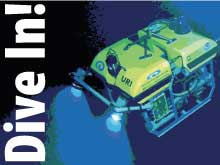
These lesson plans focus on cutting-edge ocean exploration and research.
Education Lesson Plans
The National Oceanic and Atmospheric Administration (NOAA) has a great opportunity to reach out in new ways to teachers, students, and the general public through its ocean exploration efforts and share the excitement of daily at-sea discoveries and the science behind its major ocean exploration initiatives with people around the world. The GalAPAGos: Where Ridge Meets Hotspot expedition presents a unique opportunity to engage explorers of all ages as we continue our journeys to a deep-sea world of geological activity that few have ever seen.
Ocean explorers aboard the R/V Thomas G. Thompson will investigate a 400 km-long section of the Galapagos Spreading Center which is part of the global mid-ocean ridge system. The portion of the Galapagos Spreading Center where the surveys will take place is completely unexplored for hydrothermal vents and other fine-scale seafloor features. Everything mapped and imaged on this expedition will therefore be a new discovery! Using towed near-bottom sonars, hydrothermal plume sensors, and cameras, expedition explorers will seek to uncover hydrothermal, geological and biological responses to magma supply and crustal thickness along the survey region.
The GalAPAGos team will use two sonar systems: one mounted in the ship’s hull and one towed close to the seafloor. Sensors attached to the latter sonar’s sled system will be used to detect hydrothermal plumes rising from seafloor hot springs. Once the hydrothermal plumes are located, investigators will sample them with remotely-triggered water bottles to measure their chemical properties and to investigate the types of particles and microbes present in the plumes. Finally, the Medea camera will be lowered to image seafloor vents.
Educators and scientists working with NOAA developed a series of lesson plans for students in Grades 5 - 12 that are specifically tied to the science behind the GalAPAGos expedition. These lesson plans focus on cutting-edge ocean exploration and research using state-of-the-art technologies. In addition the lesson plans listed below, please see 11 additional activities developed for the Galapagos Rift 2002 Expedition.
The lesson plans are grouped into the following categories:
Grades 5-6
Grades 7-8
Grades 9-12 (Chemical, Biological, Earth, and Physical
Science)
In addition to being tied to the National Science Education Standards, the hands-on, inquiry-based activities include focus questions, background information for teachers, links to interesting Internet sites, and extensions. Web logs that document the latest discoveries and complement the lesson plans, complete with compelling images and video, will be sent back each day from sea. Teachers are encouraged to use the daily logs from the GalAPAGos: Where Ridge Meets Hotspot Expedition, which are posted on this site, to supplement the lesson plans.
Read a description of each lesson plan and/or download them
to your computer. All of the lesson plans are available in PDF format,
and may be viewed and printed with the free Adobe Acrobat Reader ![]() . To download a lesson plan, click on its title from
the listing below.
. To download a lesson plan, click on its title from
the listing below.
And Now for Something Completely Different… (10 pages, 172k)
Focus: Biological communities at hydrothermal vents (Life Science)
In this activity, students will identify and describe organisms typical of hydrothermal vent communities near the Galapagos Spreading Center, explain why hydrothermal vent communities tend to be short-lived, and identify and discuss lines of evidence which suggested the existence of hydrothermal vents before they were actually discovered.
How Does Your Magma Grow? (6 pages, 224k)
Focus: Hot spots and midocean ridges (Physical Science)
In this activity, students will identify types of plate boundaries associated with movement of the Earth’s tectonic plates, compare and contrast volcanic activity associated with spreading centers and hot spots, describe processes which resulted in the formation of the Galapagos Islands, and describe processes that produce hydrothermal vents.
Where Did They Come From? (7 pages, 196k)
Focus: Species variation in hydrothermal vent communities (Life Science)
In this activity, students will define and describe biogeographic provinces of hydrothermal vent communities, identify and discuss processes contributing to isolation and species exchange between hydrothermal vent communities, and discuss characteristics which may contribute to the survival of species inhabiting hydrothermal vent communities.
For More Information
Contact Paula Keener-Chavis,
Director, Education Programs
NOAA Office of Ocean Exploration
Other lesson plans developed for this Web site are available in the Education Section.




























